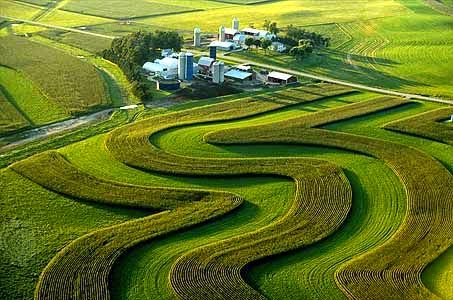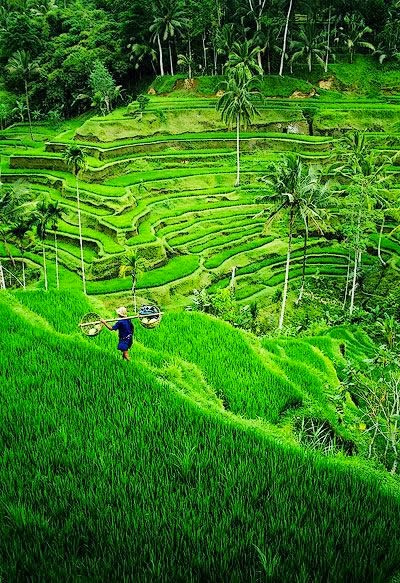 |
| Sustainable Agriculture |
Sustainable agriculture is the practice of growing and harvesting crops in a manner that will allow the land to return to its pre cultivation state. It seeks to maintain the quality of air, soil, and water resources for future human use and for wildlife.
Most twentieth century agricultural practices were based upon continued economic growth. This practice demonstrated dramatic increases in production but had negative impacts on the environment through the losses of plant and animal habitats, depletion of soil nutrients, and increases in pollution of water supplies. The concept of sustainable development is based on using renewable resources and working in harmony with ecosystems.
The World Commission on Environment and Development described the concept of sustainable development as being able “to meet the needs of the present without compromising the ability of future generations to meet their own needs.”
  |
Sustainable agriculture strives to manage agricultural activities in such away as to protect air, soil, and water quality as well as conserve wildlife habitats and biodiversity.
Problems Caused by Agriculture
Water pollution is one of the most damaging and widespread effects of modern agriculture. Runoff from farms accounts for more than 50 percent of sediment damage to natural waterways.
Cleanup of the chemicals and nutrients associated with this runoff in the United States costs an estimated $2 billion to $16 billion per year. Heavy application of nitrogen fertilizers and pesticides has raised the potential for groundwater contamination. Feedlots that concentrate manure production lead to further groundwater contamination.
Several of the most commonly used pesticides have been detected in the groundwater of at least one-half of the states in the United States. In addition, growing highly specialized monoculture crops, which requires a heavy reliance on agricultural chemicals, has depleted the natural organic nutrients that were formerly rich in North American top soils.
Research has shown that many of the farm-based chemical agents, pesticides, fertilizers, plant-growth regulators, and antibiotics are now found in the food supply. These chemicals can be harmful to humans at moderate doses, and chronic effects can develop with prolonged exposure at lower doses.
Further, widespread pesticide use has been shown to severely stress animals other than the target pest, including bee populations. Pesticides have often led to resurgences of pests after treatment, occurrences of secondary pest outbreaks, and resistance to pesticides in the target pest.
Because of these growing problems, many American farmers are turning to sustainable agriculture. The U.S. federal government has offered guidance for this transition through the Sustainable Agriculture Farm Bill, passed by Congress in 1990.
The bill provides that sustainable agriculture, through an integrated system of plant and animal production practices, can, over the long run, meet human food and fiber needs, enhance environmental quality and natural resources, make the most efficient use of nonrenewable resources, maintain economic viability of farm operations, and enhance the quality of life for farmers and consumers.
Water Conservation
 |
| Trickle irrigation |
Water is one of the most important resources for agriculture and for society as a whole. In the western United States, it allows arid lands to produce crops through irrigation. In California, limited surface water supplies have caused overdraft of groundwater and the consequent intrusion of salt water, which causes a permanent collapse of aquifers.
In order to counteract these negative effects, sustainable farmers in California are improving water conservation and storage methods, selecting drought-resistant crop species, using reduced volume irrigation systems, and managing crops to reduce water loss. Drip and trickle irrigation can also be used to dramatically reduce water usage and water loss while helping to avoid such problems as soil salinization.
Salinization and contamination of groundwater by pesticides, nitrates, and selenium can be temporarily managed by using tile drainage to remove water and salt. However, this often has adverse affects on the environment. Long-term solutions include conversion of row crops to production of drought-tolerant forages and the restoration of wildlife habitats.
   |
Contour Plowing and Terracing
One of the most important aspects of sustainable agriculture is soil conservation. Water runoff from a field having a 5 percent slope has three times the water volume and eight times the soil erosion rate as a field with a 1 percent slope.
In order to prevent excessive erosion, farmers can leave grass strips in the waterways to capture soil that begins to erode. Contour plowing,which involves plowing across the hill rather than up and down the hill, helps capture overland flow and reduce water runoff.
Contour plowing is often combined with strip farming, where different kinds of crops are planted in alternating strips along the contours of the land. As one crop is harvested, another is still growing and helps recapture the soil and prevent water from running straight down the hill.
 |
| Contour plowing |
In areas of heavy rainfall, tiered ridges are constructed to trap water and prevent runoff. This involves a series of ridges constructed at right angles to one another. Such construction blocks direct runoff and allows water to soak into the soil.
Another method of soil conservation is terracing, in which the land is shaped into level shelves of earth to hold in the water and soil. To provide further stability to soil, soil-anchoring plants are grown on the edges of the terraces. Terracing, although costly, can make it possible to farm on steep hillsides.
Some soils that are fairly unstable on sloping sites or waterways can require that perennial species of grasses be planted to protect the fragile soil from cultivation every year. Green Manure Farmers also use green manure—crops that are raised specifically to be plowed under—to introduce organic matter and nutrients into the soil.
Green manure crops help protect against erosion, cycle nutrients from lower levels of the soil into the upper layers, suppress weeds, and keep nutrients in the soil rather than allowing them to leach out.
 |
| Rice fields terracing |
Legumes such as sweet clover, ladino clover, and alfalfa are excellent green-manure crops. They are able to extract nitrogen from the air into the soil and leave a supply of nitrogen for the next crop that is grown.
Some crops, such as beans and corn, can cause high soil erosion rates because they leave the ground bare most of the year. In sustainable farming, crop residues are left on the ground after harvest. Residues help reduce soil evaporation and even excessive soil temperatures in hot climates.
Many farmers choose to use cover crops rather than residue crops. Which cover crop to use depends on which geographical area farmers live in and if they wish to control erosion, capture nitrogen in the fall, release nitrogen to the crop, or improve soil structure and suppress weeds.
Cover Crops
When planting crops with high nitrogen requirements, such as tomatoes or sweet corn, farmers can use cover crops such as hairy vetch or clover. Both these cover crops decompose and release nutrients into the soil within one month. To fight erosion, a farmer might choose a rapid-growing cover crop, such as rye.
Rye provides abundant ground cover and an extensive root system below the soil to stop erosion and capture nutrients. Alfalfa, rye, or clover can be planted after harvest to protect the soil and add nutrients and can then be plowed under at planting time to provide a green manure for the crop.
 |
| Rye grass, rapid growing cover crops |
Cover crops can also be flattened with rollers, and seeds can be planted in their residue. This gives the new plants a protective cover and discourages weeds from over taking the young plants. Use of natural nitrogen also reduces the risk of water contamination by agricultural chemicals.
Reduced Tillage
Sustainable agriculture emphasizes the use of reduced tillage systems. There are three reduced tilling systems that sustainable farmers use to disturb the soil as little as possible.
Minimum till involves using the disc of a chisel plow to make a trench in the soil where seeds are planted. Plant debris is left on the surface of the ground between the rows, which helps further prevent erosion. Several sustainable planting techniques help prevent soil erosion.
Conser-till farming uses a coulter to open a slot just wide enough to insert seeds without disturbing the soil. No-till planting involves drilling seeds into the ground directly through the ground cover or mulch.When mulch is still in place, a narrow slit can be cut through the cover or crop residues in order to plant the new crops.
Crop Rotation vs. Monoculture Planting the same crop every year on the same field can result in depleted soils. In order to keep the soil fertile, nitrogen-depleting crops (such as sweet corn, tomatoes, and cotton) should be rotated every year with legumes, which add nitrogen to the soil. Planting a winter cover crop, such as rye grass, protects the land from erosion.
Such cover crops will, when plowed under, provide a nutrient-rich soil for the planting of a cash crop. Crop rotations improve the physical condition of the soil because of variations in root depth and cultivation differences.
In nature, plants grow in mixed meadows, which allow for them to avoid insect infestations. Agricultural practices that use monoculture place a great quantity of the food of choice in easy proximity of the insect predator. Insects can multiply out of proportion when the same crop is grown in the field year after year.
Since most insects are instinctively drawn to the same home area every year, they will not be able to proliferate and thrive if crops are rotated and their crop of choice in not in the same field the second year.
Crop rotation not only helps farmers use fewer pesticides but also helps to control weeds naturally. Some crops and cultivation methods inadvertently allow certain weeds to thrive.
Crop rotations can incorporate a successor crop that eradicates the weeds. Some crops, such as potatoes and winter squash, work as cleaning crops because of the different style of cultivation that is used on them. Pumpkins planted between rows of corn will help keep weeds at bay.
Integrated Pest Management
Most sustainable farmers use integrated pest management (IPM) to control insect pests. Using IPM techniques, each crop and its pest is evaluated as an ecological system.
A plan is developed for using cultivation, biological methods, and chemical methods at different timed intervals. Although effective, profitable, and safe, the IPM techniques have been widely adopted only for a few crops, such as tomatoes, citrus, and apples.
The goal of IPM is to keep pest populations below the size where they can cause damage to crops. Fields are monitored to gauge the level of pest damage. If farmers begin to see crop damage, they put cultivation and into effect to control the pests.
Techniques such as vacuuming bugs off crops are used in IPM. IPM encourages growth and diversity of beneficial organisms that enhance plant defenses and vigor. Small amounts of pesticides are used only if all other methods fail to control pests.
It has been found that integrated pest management, when done properly, can reduce inputs of fertilizer, lower the use of irrigation water, and reduce pre harvest crop losses by 50 percent. Reduced pesticide use can cut pest-control costs by 50 to 90 percent and increases crop yield without increasing production costs.